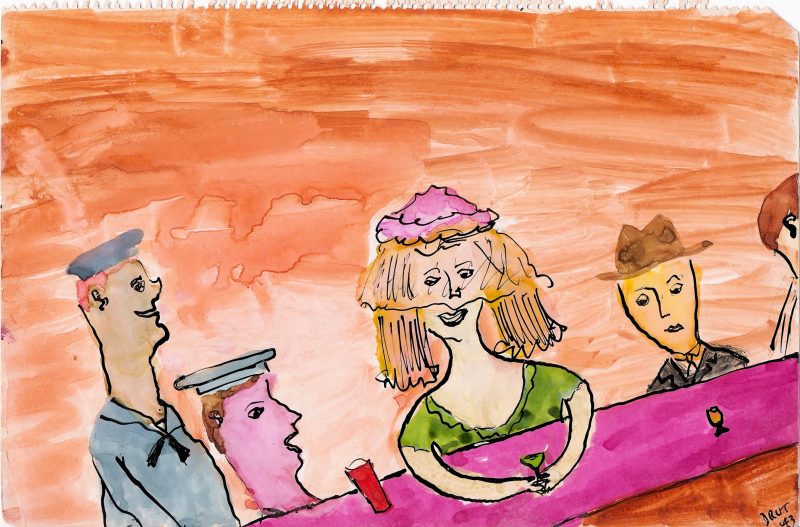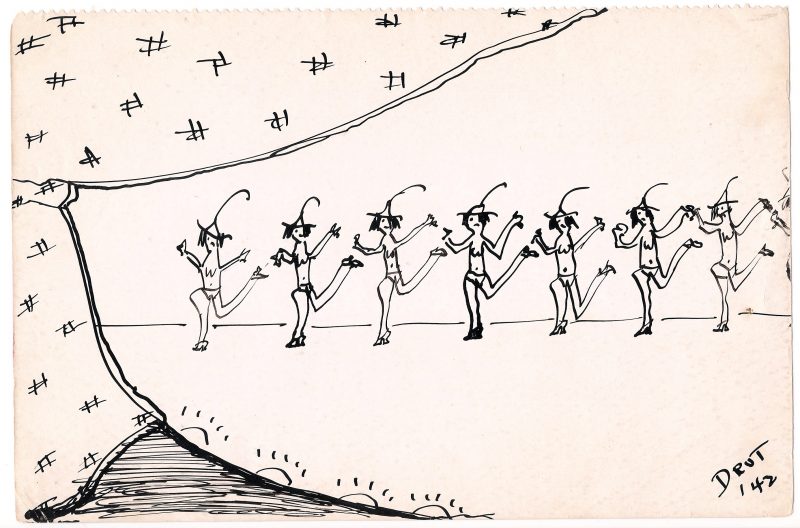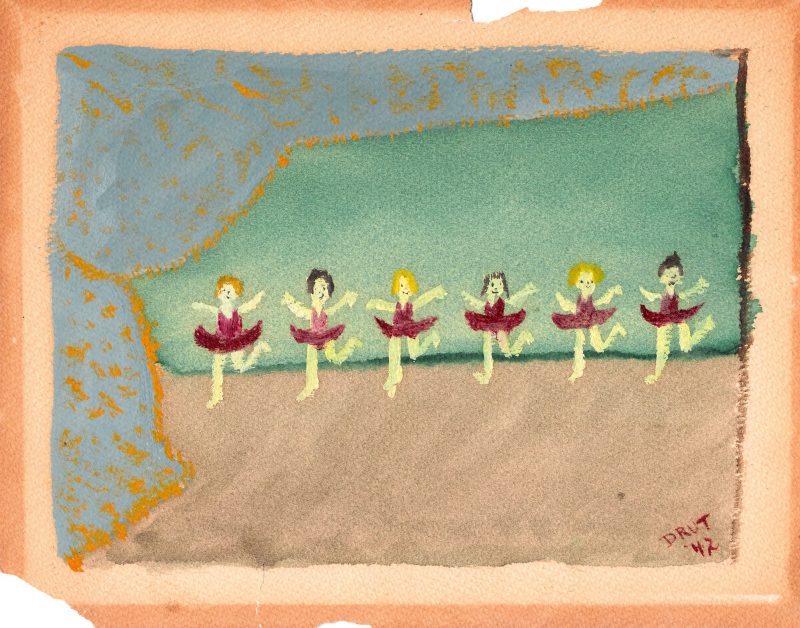1940’s Watercolor Drawings of New York Night Life
Set of 2 watercolor drawings, acquired from estate of eldery gay gentleman. Included letters, photographs & artwork. These drawings are sold seperately, and depict two familiar scenes in New York in the earlyforties.
- ‘Lady with Hat & Sailors at Bonnie’s’, Watercolor and ink on page from a sketchbook (see ring holes at top of page). Measures 9 x 6 inches. Documents included in the estate sale box mentions this being the Bonnie’s Stonewall Inn. Signed and dated lower bottom ‘Drut 1943’. Asking $325 each.
- ‘Burlesque Dancers at Minsky’s Burlesque Theatre’, Watercolor and ink on watercolor textured paper / aged and yelloed with time / some tears in the paper. Measures 10 x 8 inches. Documents included in the estate sale box mentions this being Minsky’s Burlesque Theatre, even though it was closed in 1937, this was drawn in 1942, from memory. I believe this particular watercolor depicted the dnacers as ballerinas for humour. Signed and dated lower bottom ‘Drut 1942’. Asking $325 each
- ‘Burlesque Dancers at Minsky’s Burlesque Theatre’, Watercolor and ink on page from a sketchbook (see ring holes at top of page). Measures 9 x 6 inches. Documents included in the estate sale box mentions this being Minsky’s Burlesque Theatre, even though it was closed in 1937, this was drawn in 1942, from memory. Signed and dated lower bottom ‘Drut 1942’. Asking $325 each
- https://en.wikipedia.org/wiki/Minsky%27s_Burlesque
Early History:
In 1930, the Stonewall Inn, sometimes known as Bonnie’s Stonewall Inn, presumably in honor of its proprietor Vincent Bonavia, opened at 91 Seventh Avenue South. Purportedly a tearoom, a restaurant serving light meals and non-alcoholic beverages, it was in fact a speakeasy, which was raided by prohibition agents in December 1930, along with several other Village nightspots.
In 1934, a year after the end of Prohibition, Bonavia relocated to 51-53 Christopher Street, where a large vertical sign was installed with the name “Bonnie’s Stonewall Inn.” The two storefronts at 51-53 Christopher Street were constructed as stables in the mid-19th century. In 1930, the buildings were combined with one facade to house a bakery. Bonnie’s Stonewall Inn operated as a bar and restaurant until 1964, when the interior was destroyed by fire.[14][15]
In 1966, three members of the Mafia invested in the Stonewall Inn, turning it into a gay bar. It had previously been a restaurant and a nightclub for heterosexuals. The Mafia believed that a business catering to the otherwise shunned gay community might well turn a profit, as they served watered-down alcohol and demanded regular payoffs for “protection”. It was also common for the Mafia to blackmail closeted wealthy patrons.[16] The Stonewall became a popular gay bar because it had a dance floor and jukebox. While police raids were common, it was one of the only bars in the city where couples could slow dance together (even if the raids meant they would have to quickly split up).[17] Once a week a police officer would collect envelopes of cash as a payoff; as the Stonewall Inn had no liquor license, these were bribes to keep from getting shut down. Though the bar was not openly used for prostitution, drug sales and other “cash transactions” took place. Many bars kept extra liquor in a secret panel behind the bar, or in a car down the block, to facilitate resuming business as quickly as possible if the alcohol was seized in a raid. Bar management usually knew about raids beforehand due to police tip-offs, and raids usually occurred early enough in the evening that business could continue after the police had finished. In late 1969, a few months after the rebellion that started on June 28 of that year, the Stonewall Inn initially closed.



